I Thought I Wanted an Upper Blepharoplasty—What I Needed Was a Brow Lift
At 35, I decided it was finally time to go under the knife.
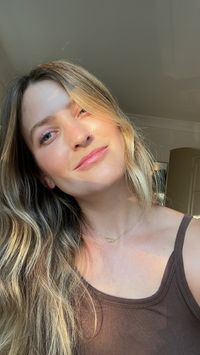

Nothing gets us more excited than talking about a not-so-little tweakment or a nip-tuck procedure. In the spirit of transparency, Marie Claire’s aesthetics column, Life in Plastic, delivers a first-hand peak into what goes on behind the doctor’s door.
My eyes have always been the defining feature of my face. They’re Mediterranean Sea-blue, almond shaped, and always the first thing people comment on when they meet me. They’re kind of my claim to fame, if you will. So in the last few years—basically after I turned 30—I felt dismayed to see that they looked more and more hooded. Pretty much everyone on my mom’s side of the family has heavy brows and hooded eyes, so I was expecting to follow in her hereditary footsteps, but it was still jarring to see pictures of myself where my eyelids looked increasingly droopy.
My immediate thought was that I needed an upper blepharoplasty, a minor plastic surgery wherein excess skin on your eyelids is removed. It’s a favorite among celebrities and influencers—2025 was even dubbed “the year of the upper bleph” by the Beauty Filter Podcast hosts.
Then, I ran into Daniel Gould, MD, Ph.D, a board-certified plastic and reconstructive surgeon, at a beauty event in Los Angeles and asked him if he thought I was a good candidate for an upper bleph. Within five seconds of looking at my face he explained that what I was seeing as excess skin on my eyelids was actually a symptom of a larger issue: my sagging brows. In fact, he said that a temporal brow lift—where the skin around the brows and upper cheek area is pulled slightly back and up from the temples—would help fix my issues. Interestingly, he said that around 90 percent of the patients he sees in his practice think they need an upper bleph when a brow lift is actually what they end up getting.
After a proper in-office consultation with Dr. Gould (where I wasn’t cornering him at a party), I decided to take my first plunge into the world of plastic surgery. Keep reading to get a full picture of why I concluded that surgery was my best option, along with a play-by-play of the entire brow lift process from consultation to healing.
My Brow Lift Consultation
I've never had plastic surgery before, so I came into my consultation with Dr. Gould pretty hot. I also contacted two other surgeons who I trust to give me some extra insights: Lara Devgan, MD, MPH, FACS, a board-certified plastic surgeon in New York City, and Jason Diamond, MD, FACS, a double-board-certified plastic surgeon in Beverly Hills. I chose Dr. Gould to perform my surgery after spending a lot of time looking at his results via Instagram; his technique is particularly subtle, which is exactly what I wanted. My biggest fear around plastic surgery is looking unnatural and, let’s face it, slightly ghoulish, but Dr. Gould reassured me that I would still feel like myself post-surgery.
So why get a brow lift instead of an upper bleph? “Many patients assume that heaviness on the upper eyelids means they need a blepharoplasty, when in fact the issue may originate from brow descent,” explains Dr. Devgan. “The brow and upper eyelid are part of a shared anatomical unit, so when the brow falls with age, it compresses the upper eyelid space, creating hooding. A brow lift repositions the brows to their youthful height, often restoring the upper eyelid platform without removing skin.” Dr. Diamond adds that he advises his patients to put a towel wrap on their hair after taking a shower, and if they like the position of their brows and appearance of their upper eyelids and eyes, the solution for them is often a brow lift.
Get exclusive access to fashion and beauty trends, hot-off-the-press celebrity news, and more.
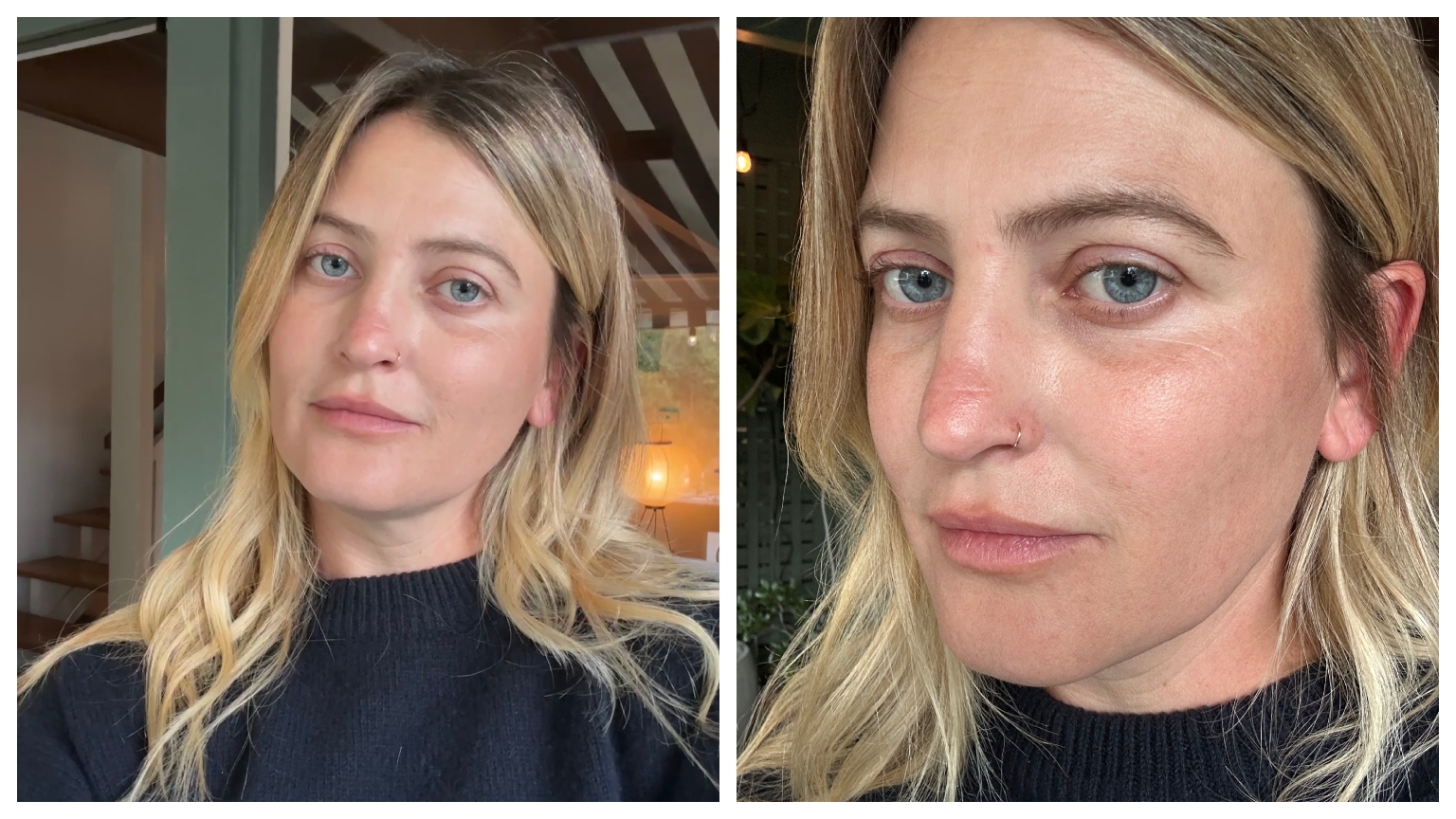
My eyes and brows before surgery.
All three surgeons note that they often perform a brow lift in tandem with an upper bleph. “The brow lift will address the skin of the brow bone and forehead, which then alleviates heaviness from the upper eyelids,” says Dr. Diamond. “We then go in to remove any excess skin of the upper eyelids with an upper blepharoplasty, as needed. This gives a much more beautiful, aesthetically pleasing result, than trying to achieve too much with solely an upper blepharoplasty.”
After chatting with Dr. Gould, I decided not to get an upper bleph as well as the brow lift, mostly because I was slightly nervous to start my plastic surgery journey with two procedures with different healing protocols. I also looked at photos of Dr. Gould’s results on women with similar anatomy who had made the same decision not to get the bleph and I loved their results. I instead opted to get CO2 laser treatment around my eyes, which helps tighten and renew the skin.
Beyond the aesthetic results a brow lift would give me, the major reason I wanted to get the surgery was to help alleviate the tension headaches I was getting along my left brow. Basically, over the last few years, I’ve noticed my left brow especially started to ride really high and constantly pull up without me actually thinking about it. This constant tension in my muscle was causing serious fatigue at the end of the day as well as some new wrinkles on top of my brow. Dr. Gould explained what was happening: “Your brain is sensing that heaviness in the upper eyelid and it's recruiting the forehead muscle, which we call the frontalis, to lift the brow in compensation. This makes the brow look high, but it's an overactive muscle response, not the actual brow position. After surgery, the compensation will relax so the brow may settle into a more natural position."
After spending some time going over prep and recovery (which I’ll get into next), Dr. Gould and I chatted a lot about the benefits of getting small plastic surgery adjustments while you’re younger (I’m 35). Beyond the fact that younger bodies have an easier time healing and less excess skin to maneuver around, Dr. Gould’s point of view was that patients want something that looks untouched, which is easier to achieve when you’re younger before many of the effects of aging have set in.
“They don’t want to get to a point where they have to look back,” he says. “Techniques have evolved that are more precise, less invasive, and more natural. And it's increasingly often that I see patients who are trying to address this early descent in their 30s. Because people look at your eyes, and if you look sad and tired, people think you're sad and tired, and then they act sad and tired. This is the hidden thing that we really don't stress enough, that the way you look affects people's emotions around you, and that affects you. And when we brighten you up, people around you are brighter, and it changes your entire perception.”
What Does a Brow Lift Entail?
In terms of technique and what’s actually happening during a brow lift surgery, it depends on the type of brow lift you’re getting. Dr. Devgan broke down the four types of brow lifts: Temporal (Lateral) Brow Lift, which focuses on lifting the outer brow only (this is what I got); Endoscopic Brow Lift, where small incisions behind the hairline with a camera-assisted elevation (Dr. Gould also used this technique for my surgery); Coronal Brow Lift, which involves a longer incision across the scalp, and effective in severe cases or those with high foreheads; and Pretrichial Brow Lift, where incisions are made along the hairline, and is ideal for patients with high foreheads who don’t want further vertical elongation.
This is the hidden thing that we really don't stress enough, that the way you look affects people's emotions around you, and that affects you.
Dr. Daniel Gould
For my surgery, Dr. Gould took a hybrid endoscopic approach. Two small incisions were placed behind the hairline at the temple, addressing lateral brow descent. The procedure involves elevating soft tissue, repositioning deeper structures, and anchoring them using sutures or bone tunneling. A permanent “horn stitch” is applied to secure the scalp skin to the bone to prevent internal accumulation. Overall, the lateral portion—meaning, the sides of my eyes and brows rather than the top arch—is lifted more than the central portion to rebalance facial tension and address heaviness at the corners of the eyes.
Prep For My Brow Lift Surgery
- Two months before surgery: Starting two months before surgery, my main priority was skincare. “Healthier skin before surgery means you’ll get better laser results, less downtime, and a way stronger barrier to protect the healing tissues,” says Dr. Gould. My specific routine focused on incorporating exosomes via the Plated Intense Serum. Dr. Gould explains that Plated is formulated with exosomes derived from human platelets, which boost natural healing factors and support tissue repair. I also used a prescription compounded tretinoin cream that Dr. Gould formulated; I incorporated it every fifth evening since I have sensitive, rosacea-prone skin and didn’t want to trigger a flare-up. On other nights I used Dr. Diamond’s Metacine Instafacial Collection Trio of serums and moisturizer. Honestly, my skin has never looked better after this two-month regimen.
- Two weeks before surgery: I wanted to start with a clean slate ahead of my surgery, so I went to my favorite injector, Grace Jensen, FNP-BC at JECT in Los Angeles to dissolve some old under-eye filler that had migrated a bit. I also made sure to stop taking any of my supplements, including my Seed probiotic, calcium, and B12—basically, anything that could stick around in my body and mess with my blood’s ability to clot or interact badly with anesthesia.
- The two-week mark was also when I stopped drinking any alcohol, switched from Ibuprofen to Tylenol, and made sure to keep my face protected from too much sun (which could cause the CO2 laser to trigger unwanted pigmentation). I also tried to keep my diet as clean and protein-rich as possible (“tried” is the operative word here) to help my body be as prepped as possible for healing.
- Five days before surgery: In the week before surgery, Dr. Gould recommended that I take the HealFast Pre-Op supplement, which can provide foundational recovery support before your surgery. “There's lots of good data showing [HealFast] improves healing,” says Dr. Gould. “It has HMB (beta-hydroxy beta-methylbutyrate) which is a precursor your body uses to make its own growth hormone.” There is also a post-op formula, however it contains biotin, which I’m allergic to, so I skipped it. You’ll also need to remove your nail polish before surgery—I had a gel manicure so I made sure to visit my nail tech the week before surgery and swap to a clear, regular polish.
- A few days before surgery: Two days before surgery, I was advised to shower using antiseptic soap and start taking Colace stool softener to help alleviate any constipation caused by the pain meds I’d be taking. Because I knew I wasn’t going to want to wash my hair for a few days (and also because, why not), the day before surgery, my mom and I went to a Japanese head spa where our hair was washed multiple times. That night, I showered with Hibiclens and made sure not to put on any body lotion. Just like with any surgery where you’re under general anesthesia, I was advised to stop eating or drinking after 10pm. I took a half of a Xanax to calm any nerves and passed out.
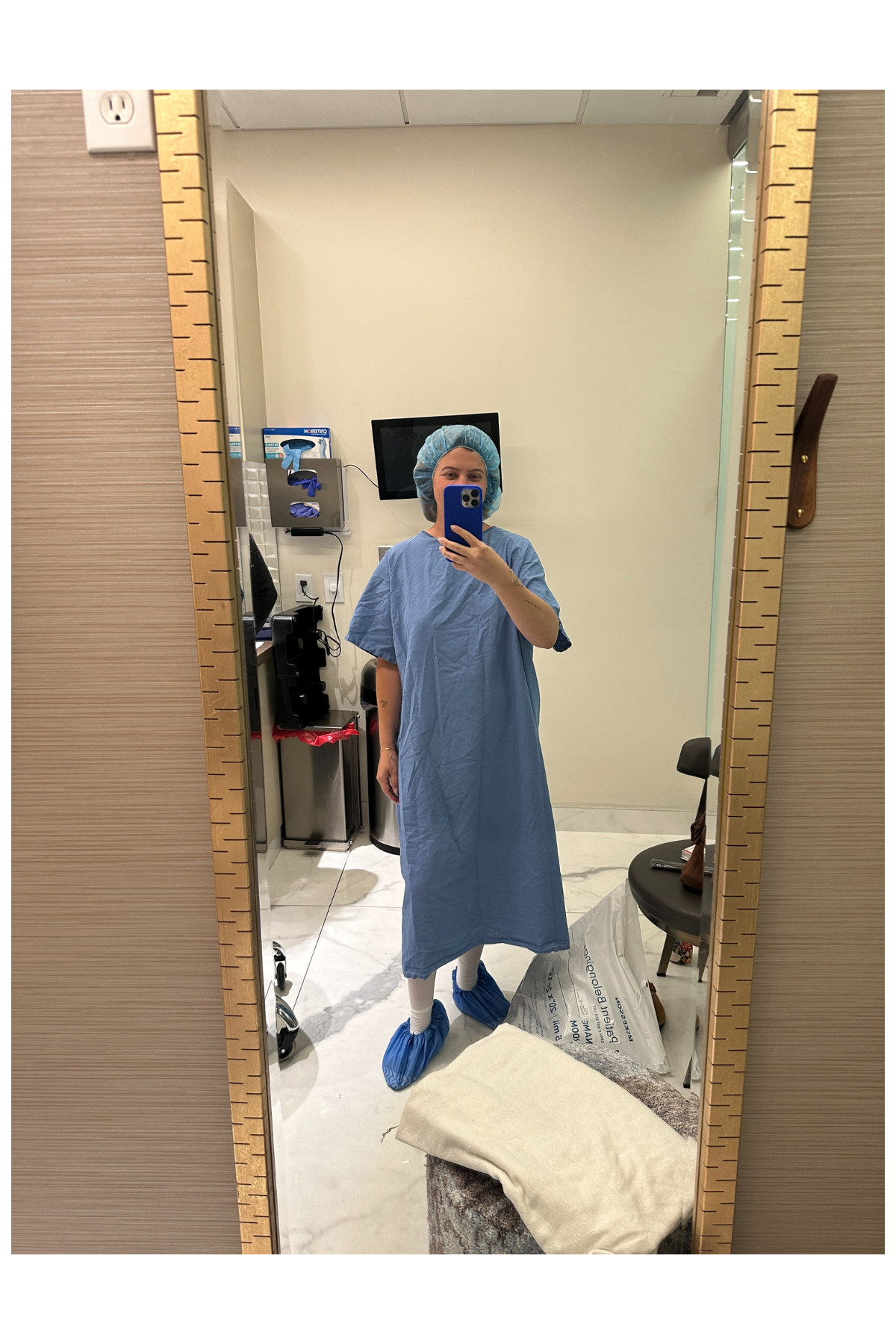
A final mirror selfie before going in for brow lift surgery.
The Day of My Brow Lift Surgery
The day of my surgery, I wore a button-up PJ shirt that I didn’t have to pull over my head and comfy sweats I could pull on. I set up my bed with a wedge pillow to keep me upright and on my back so it would be ready to go when I got home. My mom and I arrived at the surgery center at 6:00am and were greeted by one of the OR nurses. We talked through any leftover recovery questions I had and she gave me a dose of Aprepitant, a medication used to prevent nausea. I also got my first dose of Journavx, a non-opioid pain medication that was recently approved by the FDA, which I would take for the next five days.
Dr. Gould then came in to make sure we were on the same page about the process (we were) and mark up my face for reference in the OR. Finally, the IV went in and I was out.
About two hours later, I woke up from anesthesia looking like a Q-Tip—I had my head wrapped in gauze and my forehead was covered in surgical tape. Honestly, I felt pretty with it other than some leftover shakes from the anesthesia. I never experienced any acute pain—it felt mostly like an annoying hangover headache. When we got home, my mom was all ready to help me up the stairs, but truthfully I felt totally lucid and not at all wobbly. Still, I will take any excuse for a bed-rot day, so she gave me a dose of my antibiotic, a Percocet, and a stool softener, and we started a Lord of the Rings marathon.
My Brow Lift Surgery Recovery
- Days 1-3 Post-Op: The next morning, I still had the hangover-style headache, but I opted to take Tylenol instead of Percocet. I was excited to see that I didn’t have any major swelling and there were no signs of black eyes or ruptured blood vessels in my eyes. We headed back to Dr. Gould’s office to remove the gauze wrap and so that I could get the CO2 laser around my eyes. He also injected my forehead and eye area with a lot of Dysport—way more than I typically get. Dr. Gould explained that he uses a neurotoxin at this stage to help the skin and muscles stay super still while they’re healing, which helps everything heal more evenly. I also sat under a medical-grade red light therapy panel for about 20 minutes.
- From there, I went directly to Oxynergy2 for my first of three 60-minute hyperbaric oxygen therapy sessions. “Hyperbaric oxygen therapy is a no-brainer,” says Dr. Gould. “It increases oxygenation of the tissues, reduces swelling, and accelerates recovery.” During these sessions, which I did for three consecutive days after surgery, I sat in a pressurized chamber (it feels like the pressure you experience in an airplane) with a cannula in my nose that delivered super-concentrated doses of 100 percent oxygen. (For reference, the air we breathe naturally is about 21 percent oxygen.) I’m quite sure these sessions were a big reason why I recovered so fast.
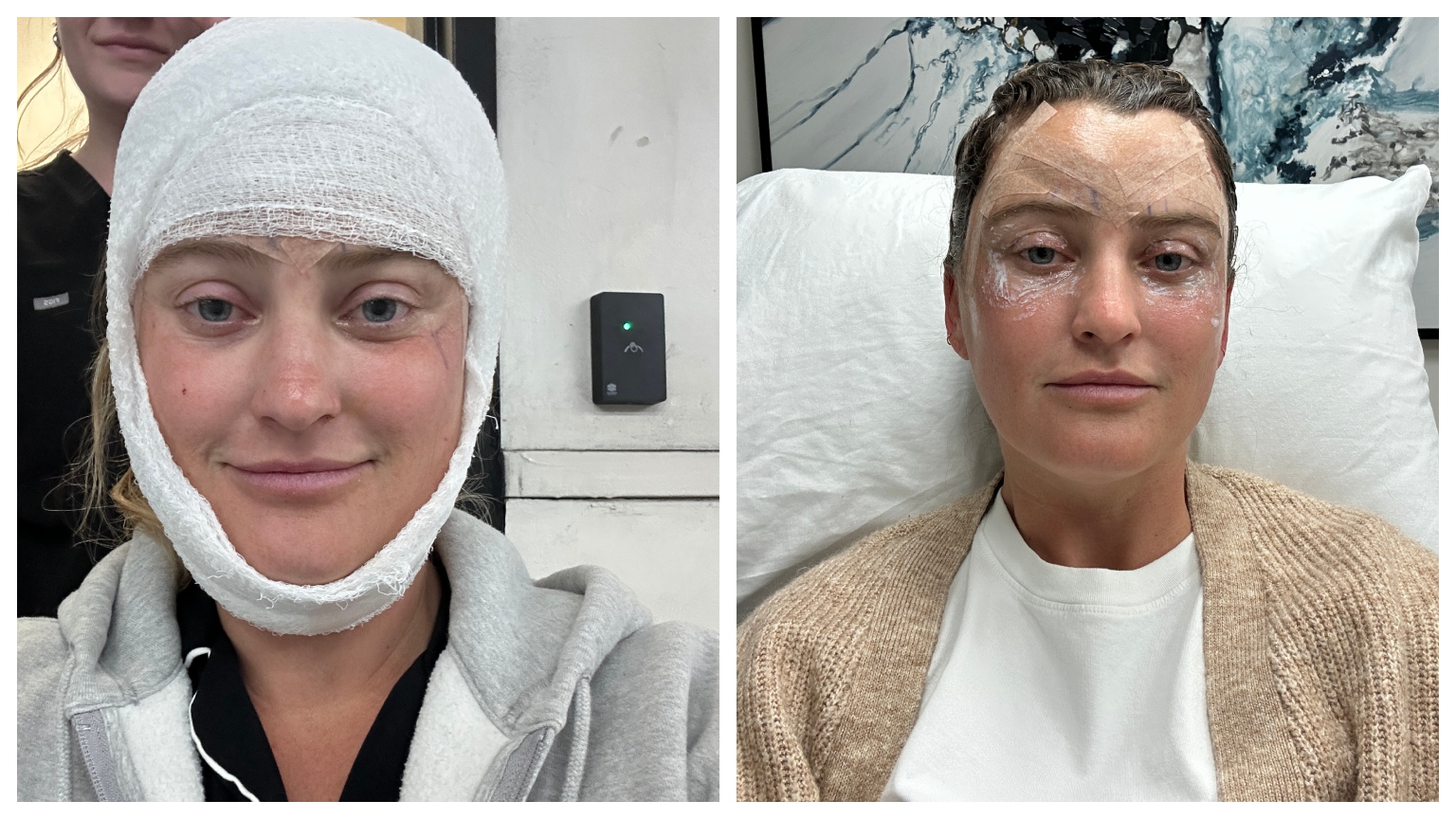
(L to R): Immediately after brow lift surgery; the morning after brow lift surgery.
- Over the next few days, my face swelled pretty dramatically as I was healing from the CO2 laser. This is something I was prepared for since that’s the reaction I almost always get from ablative lasers (see: my face after getting HALO), but it’s still a bit jarring. For me, it takes about three to four days for the swelling to go down and all the MENDS (the brown, sandpaper-like scabs created by the laser) to flake off. During that time, my skincare routine only consisted of Alastin Regenerating Skin Nectar, Aquaphor, a ton of Dr. Loretta Universal Glow Mineral SPF 40, and a wide-brimmed hat.
- Three-days post-op, I went back to Dr. Gould’s office to have the small stitches at the back of my head removed. The incisions along my hairline had dissolvable stitches that would come out on their own, and I didn’t need to put any kind of ointment on them. I finally felt ready to take a proper shower and wash my hair (even though I had been cleared to do so as soon as the gauze came off), which was kind of a wild experience. The entirety of the top of my head was numb so I had to be careful about the heat and how much I was scrubbing. I also let my hair air-dry for the next few days because I was nervous about heat styling. The hair around the incision sites felt really oily for about a week, which Dr. Gould said is normal since we had just disrupted the hair follicles. After a few washes, massaging my scalp even along the incision points felt like no big deal, and the dissolvable stitches had all fallen out by about the 10-day post-op mark.
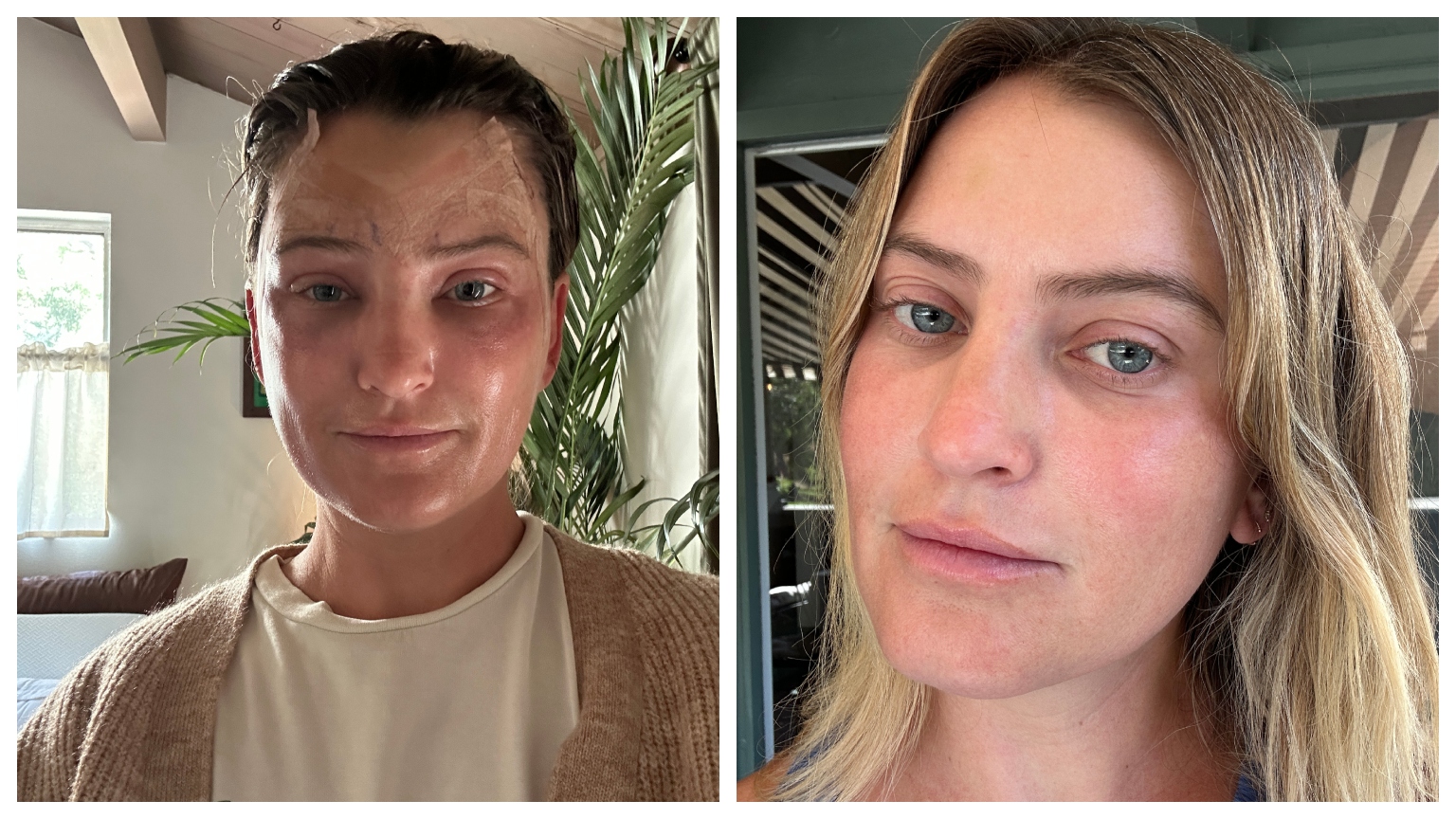
(L to R): Two days post-brow lift surgery; one week post-brow lift surgery.
- Day 10+ Post-Op: After 10 days, I started seeing celebrity-loved Brazilian masseuse Shirlei Silva, the owner of Shila Beauty Center in Beverly Hills, for lymphatic drainage massages. She’s worked on my body before, so I was excited for her to help get the remaining swelling in my temples, inner eye, and forehead down. “Surgical instruments can cause micro-damage to tissues and capillaries, which stimulates the immune response, inflammation, and the body’s natural recovery mechanisms,” says Silva. “Post-op lymphatic massage is beneficial as it helps immune cells reach the areas that require recovery, aids in fighting pathogens, and facilitates the removal of inter-tissue fluids from ‘pockets’ where it can stagnate.”
- She adds that lymphatic drainage can help prevent fibrosis and scar tissue, reduce edema and swelling, alleviate pain, and improve metabolism and the overall recovery process. “After surgery, tissues are often inflamed, so my goal is to support the face’s natural drainage system, not override it.” I’m a huge proponent of lymphatic drainage massages in general, so I believe this was a key part of my recovery.
- The most annoying things about this relatively straightforward recovery have been forcing myself to sleep on my back for six weeks (I’m a natural stomach sleeper), feeling overly frozen from the amount of ‘tox in my forehead, and the slight tenderness in my temples and forehead. I also only took the Percocet for two days, so I never felt constipated or had trouble coming off it. Overall, I’m shocked at how easy and pain-free this experience has been.
Brow Lift Costs
I’m extremely lucky that Dr. Gould and his team agreed to waive his fee for this surgery, so I only had to pay for the anesthesiologist’s time and the use of the surgery center. Typically, a brow lift surgery plus CO2 laser would be around $16,000, which can fluctuate depending on where you live.
It’s also imperative that you find a surgeon that you trust—both in terms of their results and the rapport you have. One of the reasons I felt so confident was that I felt deeply supported by not just Dr. Gould, but by his entire staff. If your surgeon is a “yes man,” saying they’ll do whatever you want—run. It’s really important that expectations are kept realistic, which applies to any plastic surgery or cosmetic procedure.
If cost isn’t a factor for you and you’re a candidate for a brow lift, I’d say unequivocally it’s worth it. The recovery was miniscule and the results were incredible—six weeks in, and I’m absolutely thrilled with how my brow lift turned out.
My Brow Lift Results
One of the things that resonated the most when making my decision to get a brow lift was when Dr. Devgan said her patients often describe feeling like their “real face” is revealed again. I can confirm this is the effect I’ve been noticing post-surgery—I feel 100 percent like myself, just refreshed. It’s like my eyes are finally back to their full glory after a few years in shadow. The results are extremely subtle but make a huge difference both in how I see myself and how others see me.
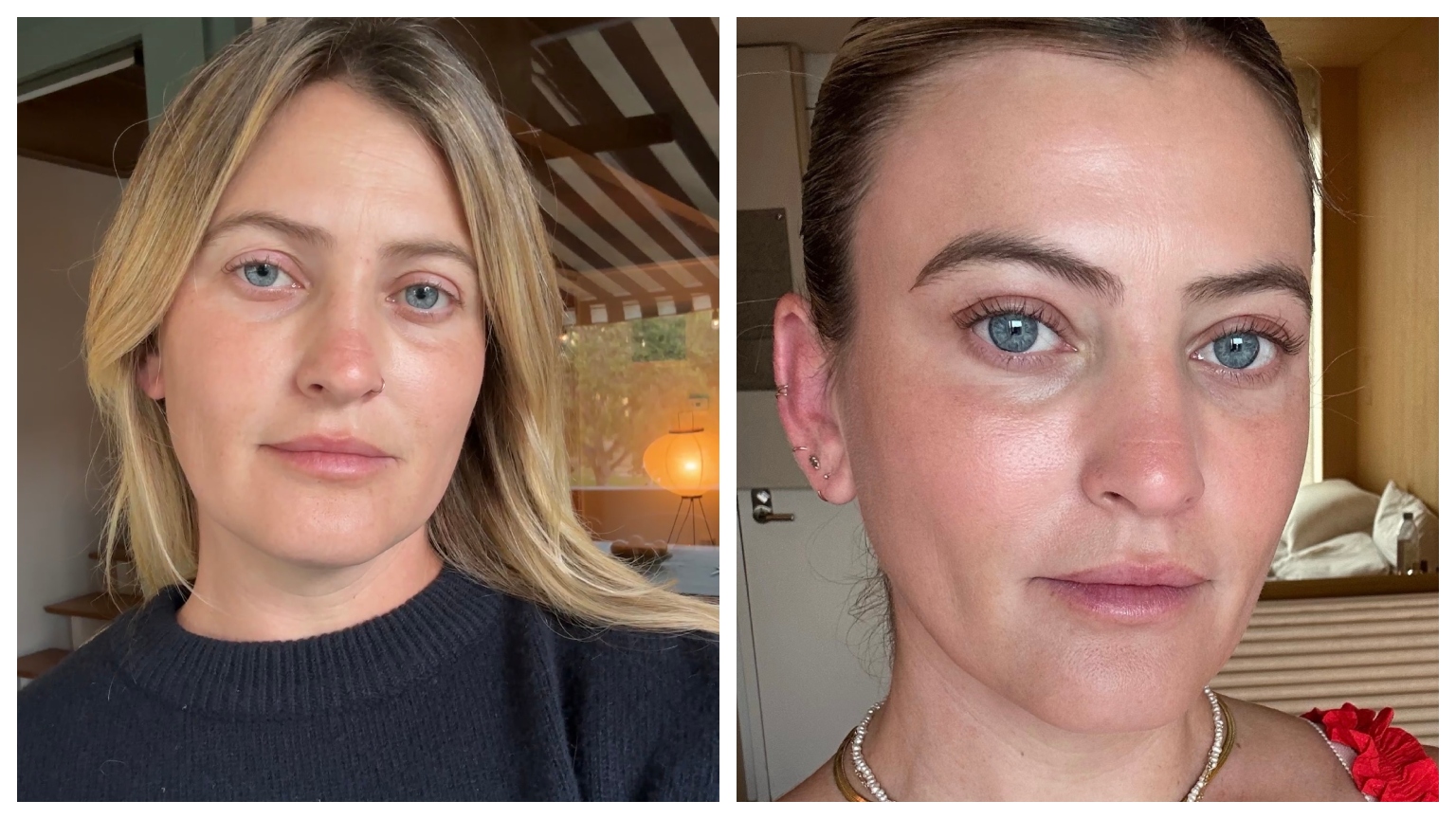
(L to R): Before my brow lift; six weeks after my brow lift.
I’m also wildly happy to report that my tension headaches are gone—you read that right. Gone. It took about three to four weeks for my muscle to relax after surgery, which Dr. Gould told me would be the case, but then all of a sudden I started noticing that I wasn’t so fatigued at the end of the day. This has been a huge game changer in my life—plus, my left eyebrow no longer arches way above the right.
At six weeks post-surgery, the only remnants of my surgery are some small lumps under my skin around my temples and hairline, which is just leftover fluid that will soften over the next few months. My scars, which you can’t see unless you part my hair at my temples, are still a bit pink but will fade over time. Overall, my brow lift results turned out exactly as I had hoped, if not better.
Meet the Experts
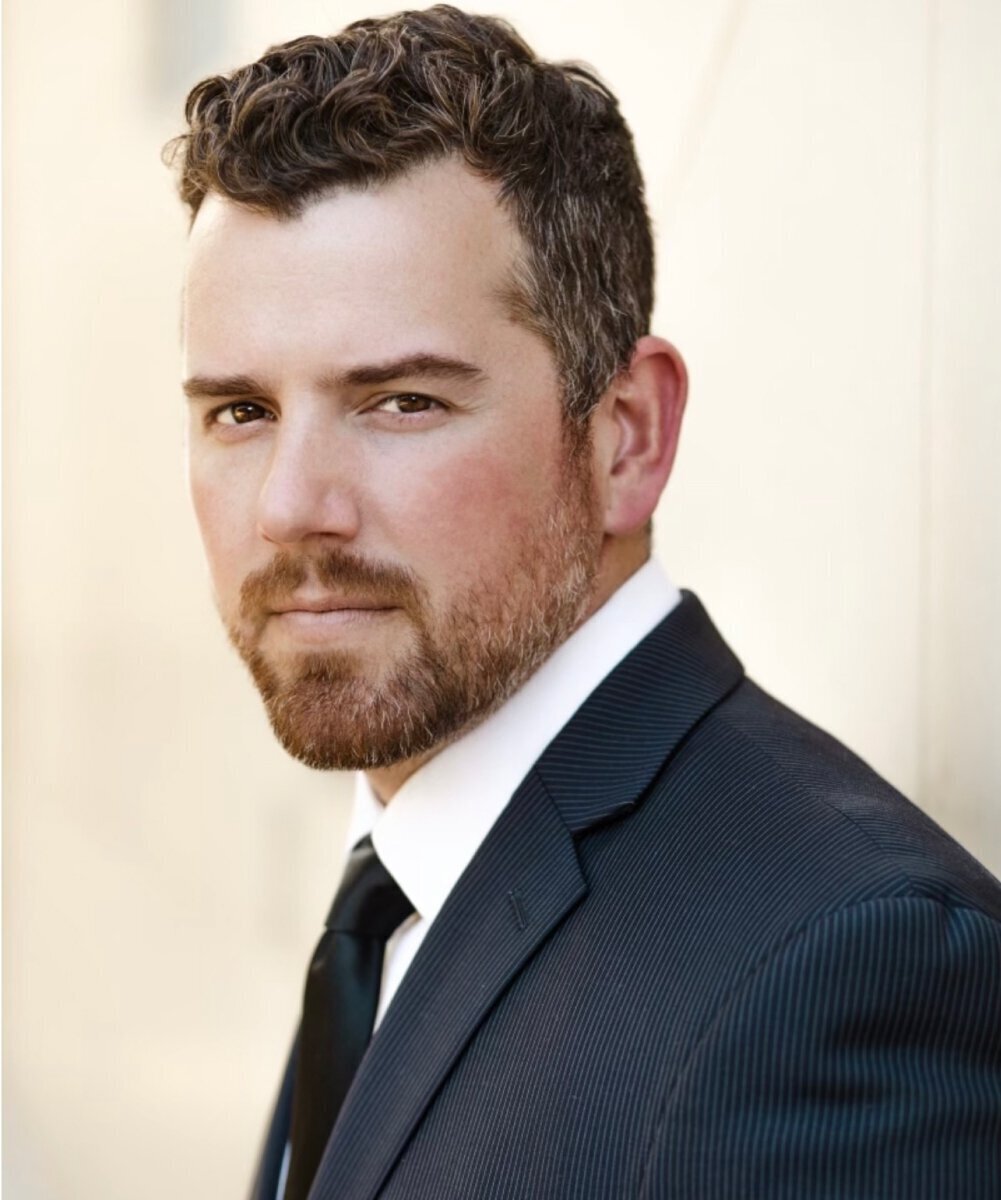
Dr. Daniel Gould completed his undergraduate education at UCLA and attended medical school at Baylor College of Medicine. He earned his Ph.D. in Bioengineering at Rice University through the prestigious NIH Medical Scientist Training Program. Dr. Gould completed his residency at the University of Southern California and further honed his expertise with fellowship training through the American Society of Aesthetic Plastic Surgery, completing the top cosmetic fellowship in the U.S. in Beverly Hills. Dr. Gould is a distinguished board-certified plastic and reconstructive surgeon with specialized training in research through the Medical Scientist Training Program. He has authored over 120 peer-reviewed articles and more than 400 presentation abstracts in reconstructive and cosmetic surgery. For almost a decade, he has worked alongside leading experts in plastic surgery, including Dr. Grant Stevens and Dr. Sheila Nazarian in Beverly Hills, where he not only refined his skills in delivering outstanding patient care and results but also learned the value of a patient-centered culture. Dr. Gould specializes in both surgical and non-surgical aesthetic services and is certified by the American Board of Plastic Surgery. A frequent presenter at national and international conferences on aesthetic and cosmetic surgery, he was honored with the Sherrell Aston Award in 2015 from the American Society of Aesthetic Plastic Surgery for his academic contributions and has received numerous similar accolades from the American Society of Plastic Surgery. Additionally, he serves on the editorial board for the Aesthetic Surgery Journal, achieving this role as one of the youngest surgeons ever appointed.
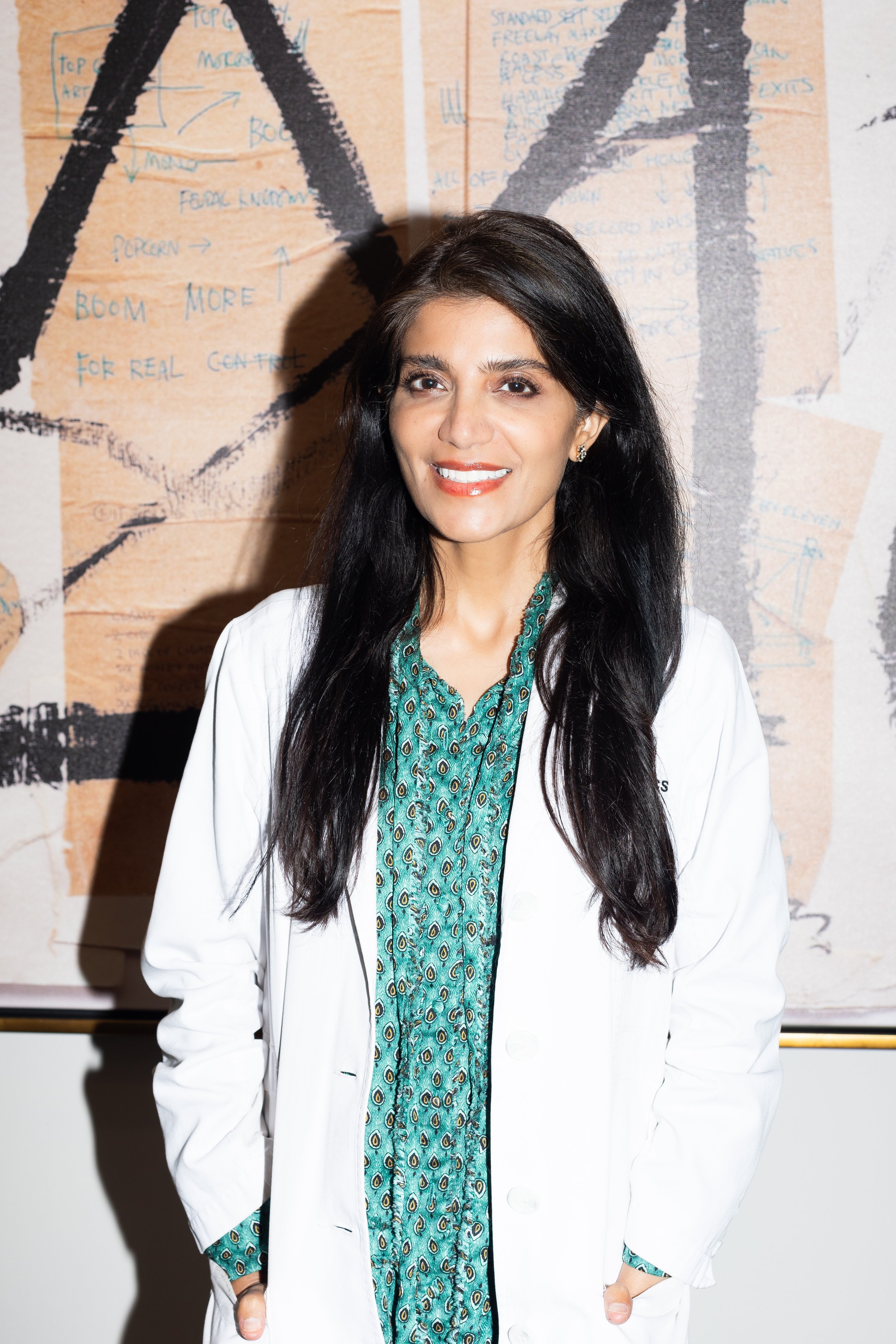
Dr. Lara Devgan is a world-renowned, board-certified plastic surgeon, based in New York City. She is known for her attention to millimeter-level details, natural results, and an exacting commitment to patient care and modern technology. She popularized the concepts of “facial optimization,” suture suspension lifting, the modern approach to nonsurgical rhinoplasty, and the use of the zip stitch in beautiful closures for blepharoplasty, facelift, and lip lift surgery. Dr. Devgan attended Yale College, Johns Hopkins Medical School, Johns Hopkins School of Public Health, Columbia/Cornell-New York Presbyterian Hospital Plastic & Reconstructive Surgery Residency & Fellowship, and obtained a coveted National Institutes of Health T32 Predoctoral Clinical Research Fellowship to study surgical outcomes. Her surgical expertise spans cosmetic and reconstructive surgery, focusing on facial aesthetics, advanced body contouring, and complex reconstructive cases. As a respected attending surgeon at Lenox Hill Hospital, Greenwich Hospital, and Manhattan Eye, Ear & Throat Infirmary, Dr. Devgan not only practices but also contributes to educating the next generation of plastic and reconstructive surgeons. She is the founder and CEO of luxury medical-grade skincare line Dr. Devgan Scientific Beauty and the host of the Beauty Bosses podcast.
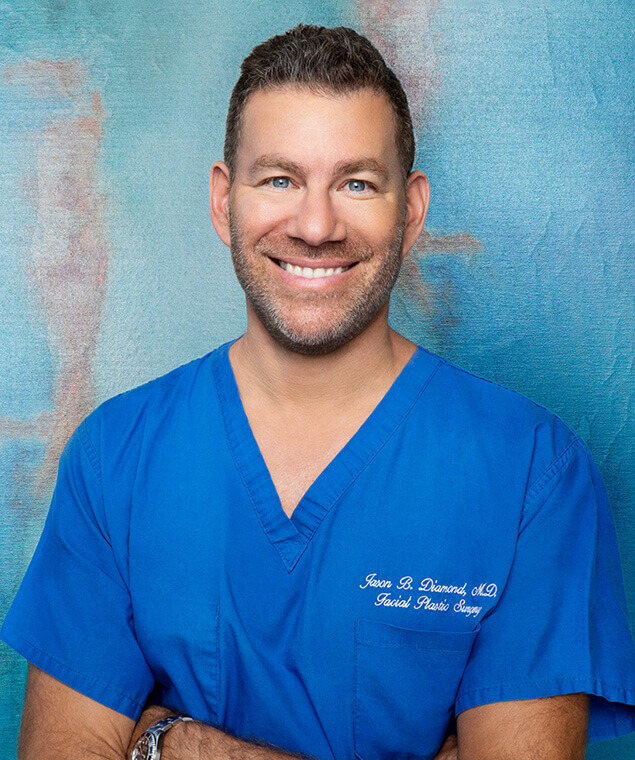
Jason B. Diamond, of the Diamond Face Institute, is considered to be a premier facial plastic surgeon by those in the industry. Dr. Diamond was born in New Jersey and completed his undergraduate degree at the University of Rochester in New York. He continued his education by completing his medical degree at the University of Rochester School of Medicine. After finishing his five-year residency, Dr. Diamond spent two years seeking out the world’s leading facial plastic surgeons so that he could perfect his technique under their tutelage. Dr. Diamond was eager to master a wide variety of extensive facial enhancement techniques and methods so that he could offer the best possible methods to his own patients. Dr. Diamond is the holder of several prestigious accolades, including a double board certification by The American Board of Facial Plastic and Reconstructive Surgery and The American Board of Otolaryngology. He has also received additional training from and is a fellow of the American College of Surgeons.
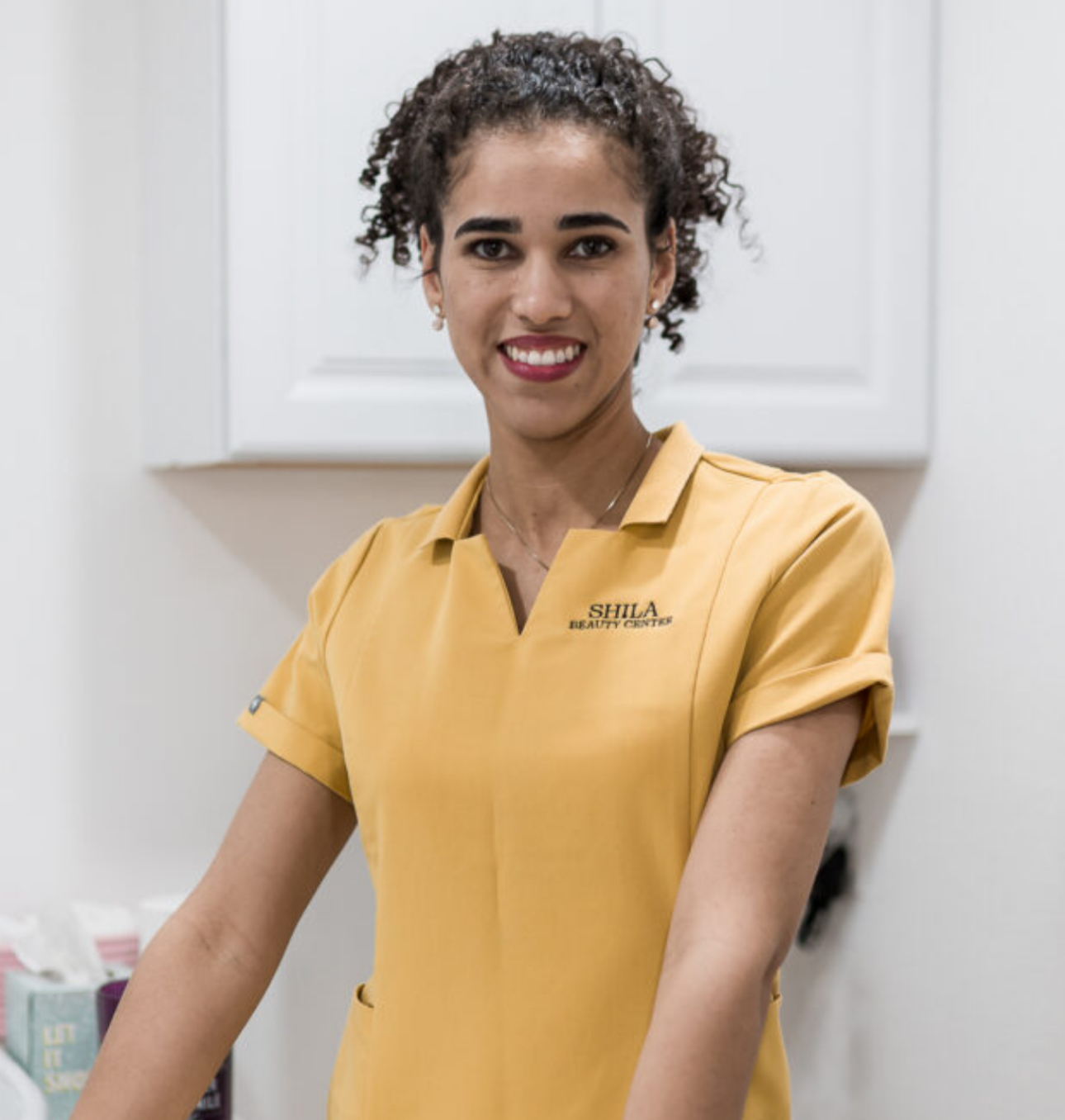
Shirlei Silva is a licensed massage therapist and the owner of Shila Beauty Center in Beverly Hills. Originally from Brazil, Silva specializes in lymphatic drainage massages and holds a certificate of achievement from Harvard Medical School in immunology. In her practice Silva offers oncology massage, post-surgery massage, and pregnancy massage, as well as several other modalities for body sculpting. Silva is a celebrity-favorite practitioner and is responsible for sculpting the faces and bodies of many of Hollywood’s most famous It-girls.
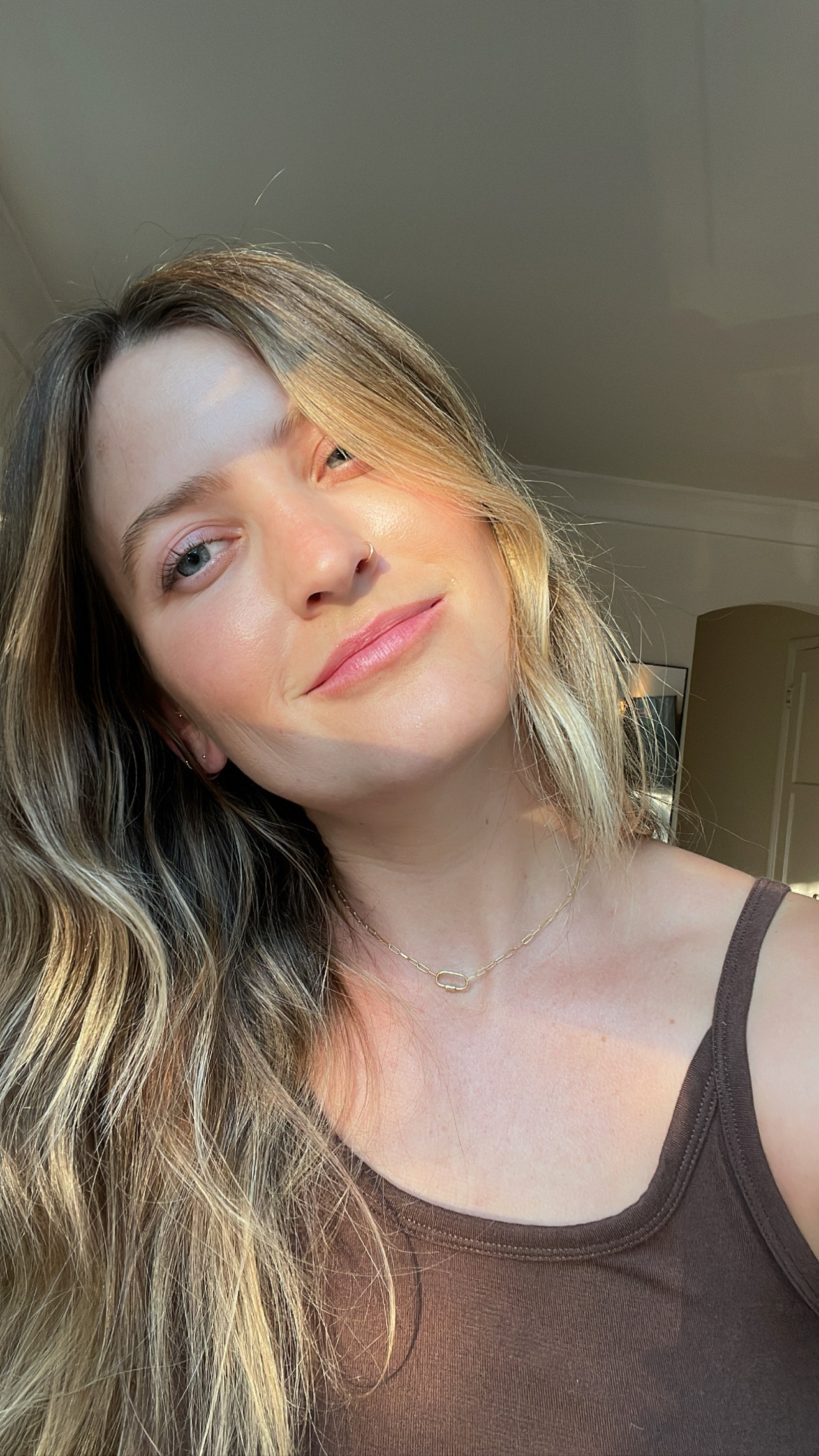
Aviel Kanter is the former editorial director of branded content for Vox Media, overseeing lifestyle content across the portfolio of brands. She has previously held roles at POPSUGAR, Condé Nast, Artforum, and Interview. Her byline can be found in publications like POPSUGAR, The Cut, Makeup.com, Brides, Curbed, and more. In her free time, you can find Aviel at a Los Angeles beach, playing an endless game of fetch with her mini Aussie, Chicken. Find her on Instagram @avielpk.